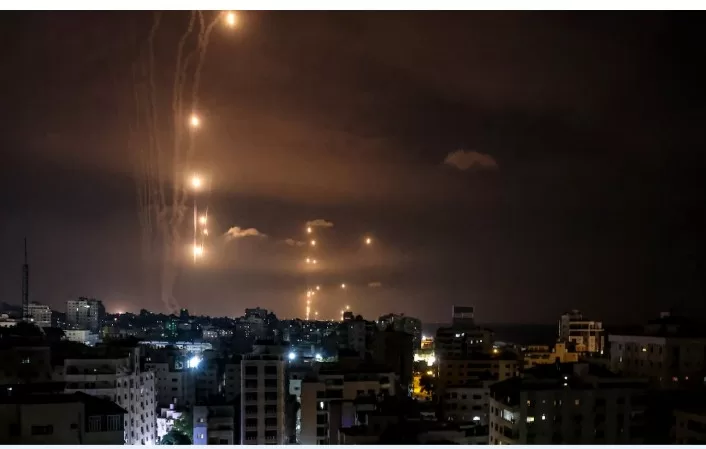In a startling turn of events, Israel finds itself embroiled in a conflict of unparalleled proportions as the Hamas group launched an audacious attack. Over 5,000 rockets rained down on Israel from the Hamas-controlled Gaza Strip in a mere 20-minute onslaught, following the declaration of “Operation Al-Aqsa Flood.”
The morning tranquility in Israel was abruptly shattered as air raid sirens echoed across the nation, prompting the deployment of the Iron Dome system, renowned as one of the world’s premier air defense systems. In a visually dramatic display, the Iron Dome swiftly intercepted and destroyed incoming rockets, illuminating the sky with bursts of flares. Nevertheless, this time, the scale and ferocity of the attack proved unprecedented.
The Iron Dome system, a ground-to-air short-range air defense system strategically placed across the country, is designed to counter rocket attacks, mortars, artillery shells, and Unmanned Aerial Vehicles (UAVs) at short range. Boasting an impressive range of approximately 70 kilometers, the system comprises three essential components: Detection and Tracking radar, Battle Management and Weapons Control, and the Missile Launcher armed with 20 Tamir Missiles.
The system has been a stalwart guardian of Israel’s skies since its deployment in 2011, stemming from the harrowing experiences of the 2006 Lebanon conflict, during which Hezbollah launched thousands of rockets, including attacks on cities like Haifa.
So, how does the Iron Dome operate?
When a hostile rocket hurtles toward Israeli territory, the Detection and Tracking radar promptly detects its trajectory, relaying critical information to the weapons control system. This control system then conducts rapid and intricate calculations to ascertain the rocket’s trajectory, speed, and potential target. If the incoming rocket poses a threat to a populated area or a vital establishment, the Missile Launcher autonomously fires the Tamir Missile, obliterating the rocket mid-air and neutralizing the danger.
The manufacturer of the Iron Dome system, Rafael Advanced Defence System, asserts an impressive success rate of 90 percent, with over 2,000 interceptions to its credit thus far.
However, in this recent conflict, the Iron Dome system found itself overwhelmed by the sheer volume of rockets unleashed by Hamas. Over several years, the Hamas terrorist group had diligently sought weaknesses in the Iron Dome’s defenses, ultimately achieving a breakthrough by employing a Salvo rocket attack—a barrage of multiple rockets launched in rapid succession—rendering it exceedingly challenging for the control system to intercept all incoming threats. This time, Hamas unleashed over 5,000 rockets within a mere 20-minute window.
Hamas has continually enhanced its rudimentary rocket technology, progressively extending its range to cover major Israeli cities, including Tel Aviv and even Jerusalem.
Each rocket launched by Hamas comes at a significantly lower cost compared to the Tamir missile utilized for interception. Therefore, the Iron Dome’s value transcends mere cost considerations, as it has consistently proven its efficacy in neutralizing threats and safeguarding lives.
In previous conflicts with Hamas, such as the 2012 confrontation, Israel reported that 85 percent of the 400 rockets fired from Gaza were successfully countered. In the 2014 conflict, over 4,500 rockets were launched by Hamas over several days, with over 800 interceptions and a remarkable success rate of 90 percent.
In response to evolving threats, Israel announced an upgrade to the Iron Dome system in 2021, aimed at bolstering its ability to counter rocket and missile salvos, as well as simultaneous interceptions of multiple unmanned aerial vehicles.
During the two-week-long Israel-Palestine conflict in May 2021, over 1,000 rockets were fired in the initial days, escalating to over 4,500 during the entire crisis. Throughout this period, officials reported a 90 percent success rate in intercepting rockets.
As Israel grapples with this latest challenge to its air defense system, it is evident that the dynamics of conflict in the region continue to evolve, leaving both sides engaged in a relentless battle of innovation and adaptation.







